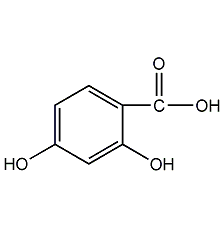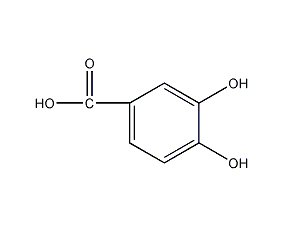2,4-dihydroxybenzoic acid


Structural formula
| Business number | 021G |
|---|---|
| Molecular formula | C7H6O4 |
| Molecular weight | 154.12 |
| label |
Resorcinol formic acid, resorcinol, β-Resoric acid, β-Resorcylic acid, (HO)2C6H3CO2H |
Numbering system
CAS number:89-86-1
MDL number:MFCD00002451
EINECS number:201-946-9
RTECS number:VH3708050
BRN number:1946213
PubChem number:24863379
Physical property data
1. Properties: White needle-like crystals
2. Density (g/mL, 25/4℃): Undetermined
3. Relative vapor density (g/mL , air=1): Undetermined
4. Melting point (ºC): 218-219
5. Boiling point (ºC, normal pressure): Undetermined
6. Boiling point (ºC, 5.2kPa): Not determined
7. Refractive index: Undetermined
8. Flash point (ºC): Not determined
9. Specific rotation (º): Undetermined
10. Autoignition point or ignition temperature (ºC): Undetermined
11. Vapor pressure (kPa, 25ºC): Undetermined
12. Saturated vapor pressure (kPa, 60ºC): Undetermined
13. Heat of combustion (KJ/mol): Undetermined
14. Critical temperature (ºC): Undetermined
15. Critical pressure (KPa): Undetermined
16. Log value of oil-water (octanol/water) partition coefficient: Undetermined
17. The upper limit of explosion (%, V/V): Undetermined
18. The lower limit of explosion (%, V/V): Undetermined
19. Solubility: soluble in ethanol, ether and hot water.
Toxicological data
None
Ecological data
None
Molecular structure data
1. Molar refractive index: 36.94
2. Molar volume (cm3/mol): 98.8
3. Isotonic specific volume (90.2K ): 299.4
4. Surface tension (dyne/cm): 84.2
5. Polarizability (10-24cm3): 14.64
Compute chemical data
1. Reference value for hydrophobic parameter calculation (XlogP): None
2. Number of hydrogen bond donors: 3
3. Number of hydrogen bond acceptors: 4
4. Number of rotatable chemical bonds: 1
5. TautomerismNumber of bodies: 12
6. Topological molecule polar surface area 77.8
7. Number of heavy atoms: 11
8. Surface charge: 0
9. Complexity: 157
10. Number of isotope atoms: 0
11. Determine the number of atomic stereocenters: 0
12. No Determine the number of atomic stereocenters: 0
13. Determine the number of chemical bond stereocenters: 0
14. Uncertain number of chemical bond stereocenters: 0
15. Number of covalent bond units: 1
Properties and stability
Has a pungent odor. Operators should wear appropriate protective clothing, gloves and use protective glasses or face shields.
Storage method
This product should be sealed and stored in a cool place.
Synthesis method
1. Resorcinol carboxylation method: First add resorcinol, potassium bicarbonate and enough water into the reaction bottle, heat it in a water bath for 4 hours, then heat it on direct fire for 30 minutes to boil. During this period Introduce carbon dioxide. After the reaction is completed, extract with ether to remove unreacted resorcinol. The resulting aqueous solution is acidified with concentrated hydrochloric acid, cooled to 0°C with water, filtered, and washed with water to obtain a crude product, which can be recrystallized in boiling water to obtain the finished product.
2. 3-hydroxyphenol carboxylation method In the presence of a mixture of potassium bicarbonate and sodium bicarbonate, 3-hydroxyphenol reacts with carbon dioxide at 110°C for 3 hours to obtain 2,4-dihydroxybenzoic acid. Yield 99.7%.
Purpose
Mainly used as dye and pharmaceutical intermediates. In the dye industry, it is used to produce acid medium pink 3BM. This product has the chemical properties of resorcinol and salicylic acid, and is also used as a chemical reagent for the colorimetric determination of iron, titanium and other elements. Also used as an antibacterial fungicide.
